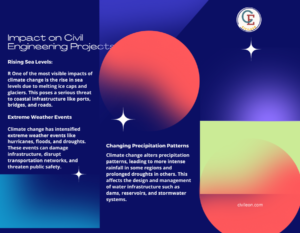In recent years, we’ve all noticed that our Climate Change. Summers are getting hotter, winters can be unpredictable, and storms are more intense. As a civil engineer and a writer passionate about these issues, I want to shed light on how climate change is impacting our field and the projects we work on.
Climate change is no longer a distant threat; it’s a pressing reality impacting various facets of our lives, including civil engineering projects. As a civil engineer, understanding its implications is crucial for designing resilient infrastructure that can withstand the challenges posed by a changing climate
Understanding Climate Change
Climate change refers to significant changes in global temperatures and weather patterns over time. While natural factors like volcanic eruptions and solar radiation influence climate, human activities such as burning fossil fuels and deforestation have accelerated these changes, leading to global warming and its consequences.
Hot Summers and Heatwaves
One of the most noticeable changes is the increase in hot summers and heatwaves. Just look at the past few years, where many regions have recorded their highest temperatures ever. For civil engineers, this means we need to rethink how we design and build our projects. For example:
Materials: Extreme heat can cause materials like asphalt and concrete to crack and deteriorate faster. We need to choose materials that can withstand higher temperatures.
Cooling Solutions: Buildings and public spaces need better cooling solutions to keep them comfortable and safe. This might mean incorporating more green spaces and water features to cool down urban areas.
Impact on Civil Engineering Projects:
Extreme Weather Events: Climate change has intensified extreme weather events like hurricanes, floods, and droughts. These events can damage infrastructure, disrupt transportation networks, and threaten public safety. Engineers must design structures capable of withstanding these events by incorporating robust materials and innovative design techniques.
Changing Precipitation Patterns: Climate change alters precipitation patterns, leading to more intense rainfall in some regions and prolonged droughts in others. This affects the design and management of water infrastructure such as dams, reservoirs, and stormwater systems. Engineers must develop adaptive strategies to ensure reliable water supply and flood control.
Heat Stress: Rising temperatures increase the risk of heat-related illnesses and infrastructure failures. Concrete and asphalt, commonly used in construction, are susceptible to heat-induced cracking and degradation. Engineers must consider the thermal properties of materials and implement cooling measures to mitigate heat stress on infrastructure.
Rising Sea Levels : Another significant impact of climate change is rising sea levels. This is a big concern for coastal cities. Higher sea levels can lead to more frequent and severe flooding, which can damage infrastructure. Here are some ways we’re addressing this:
Elevated Structures: Designing buildings and other structures to be higher off the ground can help protect them from flooding.
Better Drainage Systems: Improving drainage systems to handle larger amounts of water more efficiently is crucial. This can help prevent streets and homes from flooding during heavy rains.
Renewable Energy Infrastructure: With growing concerns about climate change, there’s a global shift towards renewable energy sources like solar and wind power. Civil engineers play a crucial role in designing and constructing renewable energy infrastructure such as solar farms and wind turbines. These projects contribute to reducing greenhouse gas emissions and mitigating climate change.
Urban Heat Island Effect: Urbanization exacerbates the urban heat island effect, where cities experience higher temperatures than surrounding rural areas due to human activities and infrastructure. Civil engineers can address this issue through urban planning strategies like green roofs, reflective pavements, and strategically placed green spaces. These measures help mitigate heat island effects and improve urban resilience to climate change.
Sustainable Transportation: Sustainable transportation systems, including public transit, cycling infrastructure, and electric vehicles, are gaining momentum as solutions to reduce carbon emissions from the transportation sector. Civil engineers are involved in designing efficient transportation networks and infrastructure that promote alternative modes of transportation and reduce reliance on fossil fuels.
Mitigation Strategies:
Resilient Design: Incorporate climate resilience into the design and construction of infrastructure projects by considering future climate scenarios and adopting adaptive design strategies.
Nature-Based Solutions: Implement nature-based solutions like green infrastructure, wetlands restoration, and coastal protection to enhance resilience and reduce the impacts of climate change on infrastructure.
Collaboration and Innovation: Foster interdisciplinary collaboration and innovation to develop sustainable solutions that address the complex challenges posed by climate change.
Impact of climate change on buildings
Heat waves and climate change can seriously damage buildings over time. When temperatures rise, materials like stone, brick, and concrete expand and can eventually crack, weakening the structure. Hotter weather also means more intense storms and flooding, which can lead to water damage. Water can seep into walls, causing mold, rot, and further weakening the building materials. The risk of wildfires increases with heat waves, posing a direct threat to buildings and causing smoke damage. Coastal buildings face additional dangers from rising sea levels and stronger waves, leading to erosion. Overall, the increased heat and extreme weather conditions make building materials age faster and need more frequent repairs, impacting the longevity and safety of these structures.
Climate change poses significant challenges for civil engineers, but it also presents opportunities to innovate and adapt. By understanding the impacts of climate change on infrastructure projects and implementing resilient design strategies, civil engineers can contribute to building a more sustainable and resilient future. It’s imperative that we prioritize climate resilience in our engineering practices to safeguard communities and infrastructure from the adverse effects of a changing climate.
For a deeper dive into construction insights and industry updates, we invite you to explore our extensive collection of construction blogs. Gain valuable knowledge and stay updated by navigating through the following blog links. Happy exploring
What is Modular and Prefabrication Technique ?
Mumbai Trans Harbour Link : Atal Setu 2024
Feel free to follow us there on Instagram and drop a comment to say hello!



